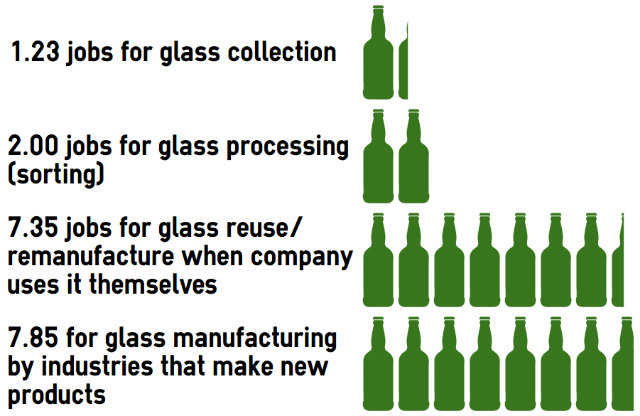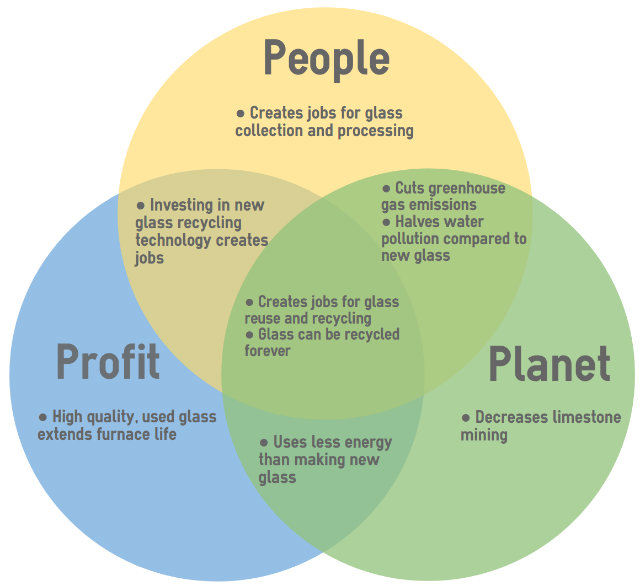
Separating materials lowers the cost of glass recycling; “100 green bottles” (CC BY 2.0) by James Cridland
Sustainability's triple bottom line integrates social, environmental, and financial factors (also known as people, planet, and profit) to achieve a balance. We look at how glass recycling easily helps people and planet, but needs some changes for a better profit. Learn more about the triple bottom line here.
The recycling industry as a whole helps with job creation. Tellus Institute, along with Sound Resource Management, looked at how recycling creates jobs. Their study showed that diverting 75% of our trash by 2030 would create 2.3 million jobs.
The study also broke down the number of jobs that would be created by each individual material. Glass would create the following number of jobs per 1,000 tons recycled:

Source — More Jobs, Less Pollution study
Recycling glass has many environmental benefits, including those below.

Sources
Recycled glass prices rose 40% in just three years1 because of the rise of single stream recycling. Single stream recycling results in cross-contamination, causing many recyclables to end up in the landfill. Glass often crushes into paper and the two cannot be separated. Thus, neither the glass nor the paper can be recycled. Learn more about single stream recycling here.
Curt Bucey, an executive vice president at Strategic Materials Inc., told the Wall Street Journal the impact of mixing recyclables. Glass arriving at their plant has gone from being 98% pure to 50%2. The company has invested in new, more expensive equipment to separate the glass. Now the company charges haulers to drop off glass, when before they paid them for it.
Some cities are responding to price increases by changing their recycling policy. Harrisburg, Pennsylvania asks residents to bring glass to recycling centers instead of mixing it with other materials2.
Sources
Recycling glass uses 30% less energy than making glass from virgin materials1. Also, used glass is less corrosive and so extends the life of the furnace2. Thus, manufacturers prefer high-quality used glass, when available, to save money.
Sources
The United States has 65 used glass processors in just 35 states1. Thus, some municipalities must haul glass a long way to a processor. Charleston, West Virginia already has residents separate all materials instead of using single stream recycling. However, they still lose money on glass, because it is heavy and thus expensive to transport2.
Sources
Some governments are employing innovative solutions to help the profit portion of glass recycling's triple bottom line. Here are two examples.
Quebec set a goal in 2015 to recycle 100% of its glass. The government plans to do this by investing in new technology to sort single stream recycling. The machines use shock waves to implode glass1. The system requires less maintenance and uses less energy than conventional machines that grind glass1.
Great Britain has a lot of green glass from imported wine. However, not many of their native industries use green glass. Thus, they do not have a local industry for recycled green glass. The Waste and Resources Action Programme (WRAP) has started a program to respond to the problem. Foreign vineyards import large containers of wine, which is then bottled in recycled glass in Britain. The program has also cut shipping costs by 40%2.
Sources
Below is a Venn diagram showing how glass recycling can achieve sustainability's triple bottom line compared with making new glass.
